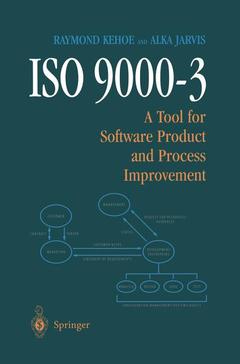Description
ISO 9000-3, 1996
A Tool for Software Product and Process Improvement
Language: English
Subject for ISO 9000-3:
Publication date: 11-2012
229 p. · 15.5x23.5 cm · Paperback
229 p. · 15.5x23.5 cm · Paperback
Description
/li>Contents
/li>
Purpose The purpose of this book is to provide the reader with an understanding of the ISO 9000-3 guideline and how it applies to the specification, development, test, and maintenance of software. We will show that the basic practices and procedures that define software engineering and the ISO guideline are, for all intents and purposes, one and the same. We hope that the readers of this book will use the information found within not only to pass the certification audit but as a tool to be used to create the well-managed engineering environment needed to create reliable, well engineered products in a consistent manner. Audience This book is intended for senior software engineers, software managers, and non software managers within software organizations whose aim is to create an engi neering environment within their company or organization. In addition, individ uals outside the software organization who have responsibility for the specification of the software product and preparing their organization to take ownership of the developed product will find this book of great interest. Finally, those who must choose software companies to do business with or audit software companies to determine their ability to engineer and maintain a software product will find this book helpful. 2 Introduction Overview This book is made up of twenty-four chapters that can be grouped into four sections. Chapter 1 through Chapter 4 set the basis for the following chapters that deal directly with the guideline.
1 Introduction to ISO 9000.- 2 Overview of Software Engineering.- 3 ISO 9000-3: Theory, Concept, Themes, Interpretation, and Critique.- 4 ISO 9000-3: Scope and Overview.- 5 Supplier Management Responsibility.- 6 Purchaser Management Responsibility.- 7 The Supplier’s Quality System.- 8 The Purchaser and Supplier Contract.- 9 Identify the Purchaser’s Requirements.- 10 Development Planning.- 11 Design and Implementation.- 12 Testing and Validation.- 13 Purchaser Acceptance.- 14 Software Maintenance.- 15 Configuration Management.- 16 Document Control.- 17 Quality Records.- 18 Measurement, Rules, and Tools.- 19 Purchasing and Including Third-Party Products.- 20 Training.- 21 The Audit Process.- 22 Specifying the Purchaser Requirements.- 23 Configuration Management Process.- 24 The Software Process Handbook as the Quality Manual.- Further Readings.
© 2024 LAVOISIER S.A.S.
These books may interest you

The 90-Day ISO 9000 Manual 214.69 €



